The Top 6 Rifle Scopes for Long Range Shooting
Don't miss your shots
Rifle scopes play a crucial role in long-range shooting. They allow shooters to accurately aim and hit targets at distances that would otherwise be impossible without magnification. Whether you're a precision shooter, a hunter, or a competitive shooter, having a high-quality rifle scope can make all the difference in your shooting performance. When evaluating the best rifle scopes, we use different criteria than binoculars or spotting scopes, as our focus is on precision and accuracy.
In this blog, we will explore the top 6 best rifle scopes for long-range shooting. These scopes have been carefully selected based on their performance, durability, and versatility. Each scope on this list offers unique features and specifications that cater to different shooting needs and preferences. Whether you're looking for a scope with a wide magnification range, precise turret controls, or exceptional optical performance, you'll find a scope on this list that meets your requirements.
Let’s dive in.
The 6 Best Rifle Scopes for Long-Range Shooting
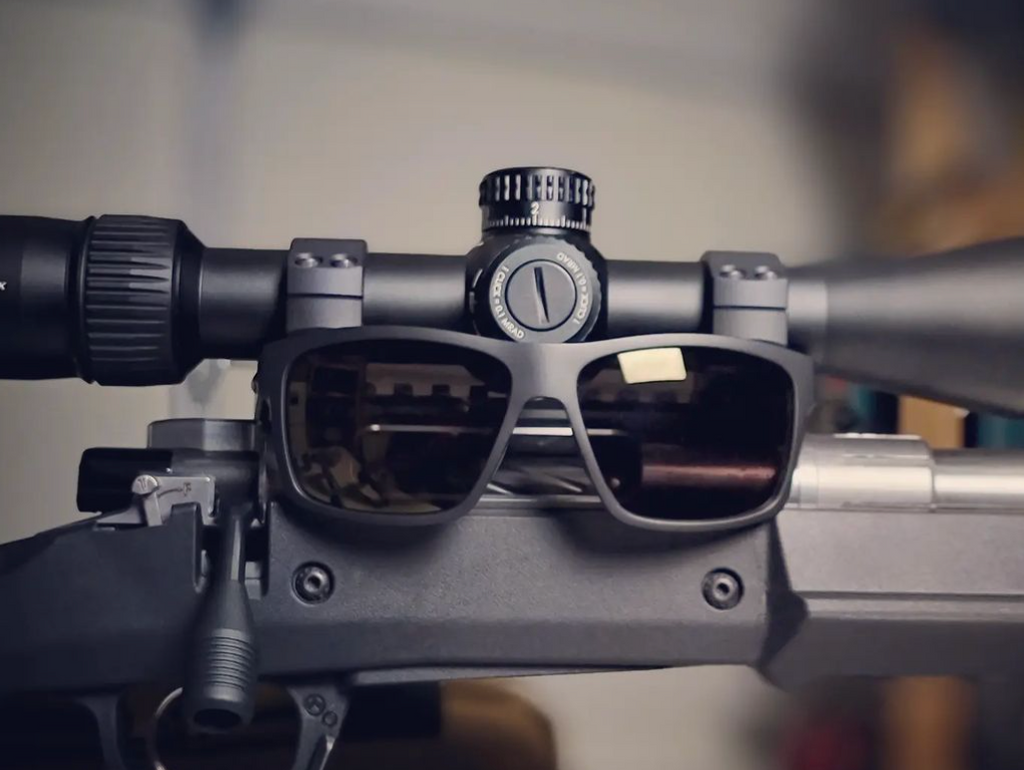
When it comes to long-range shooting, having a high-quality rifle scope is essential to keep on your checklist of good gear. Here are the top 6 best rifle scopes for long-range shooting:
- Vortex Viper PST Gen II 5-25x50 FFP
- Leupold Mark 5HD 5-25x56
- Nightforce ATACR 7-35x56 F1
- Schmidt & Bender PMII 5-25x56
- Bushnell Elite Tactical XRS II
- Zeiss Conquest V6 5-30x50
These rifle scopes are manufactured by some of the most reputable brands in the industry, known for their commitment to quality and performance. Each scope on this list offers unique features and specifications that make them stand out in the world of long-range shooting for avid outdoorsmen. Whether you're a precision shooter, a hunter, or a competitive shooter, there's a rifle scope on this list that will meet your needs and help you achieve your shooting goals.
1. Vortex Viper PST Gen II 5-25x50 FFP

The Vortex Viper PST Gen II 5-25x50 FFP is a highly regarded rifle scope for long-range shooting, especially in precision competitions. It features a first focal plane reticle, which means that the size of the reticle remains constant relative to the target as you adjust the magnification. This allows for more precise holdovers and ranging at any magnification, making it a top choice for precision scope shooters. With a 20-yards-to-infinity parallax, this scope offers exceptional clarity and accuracy at any distance.
The turret controls on the Viper PST Gen II are highly intuitive and easy to use. They provide accurate and repeatable adjustments, allowing shooters to quickly make corrections for windage and elevation. The precision of these turret controls is crucial for long-range shooting, as even the smallest adjustments can have a significant impact on bullet trajectory.
The Vortex Viper PST Gen II is known for its exceptional optical quality, offering clear and crisp images even at high magnifications. It also features Vortex's proprietary XR fully multi-coated lenses, which enhance light transmission and provide bright and vibrant images in various lighting conditions.
Overall, the Vortex Viper PST Gen II 5-25x50 FFP is a reliable and precision-focused rifle scope that is well-suited for long-range shooting. Whether you're a competitive shooter or a precision hunter, this scope delivers the performance and features needed to excel in long-range shooting.
2. Leupold Mark 5HD 5-25x56
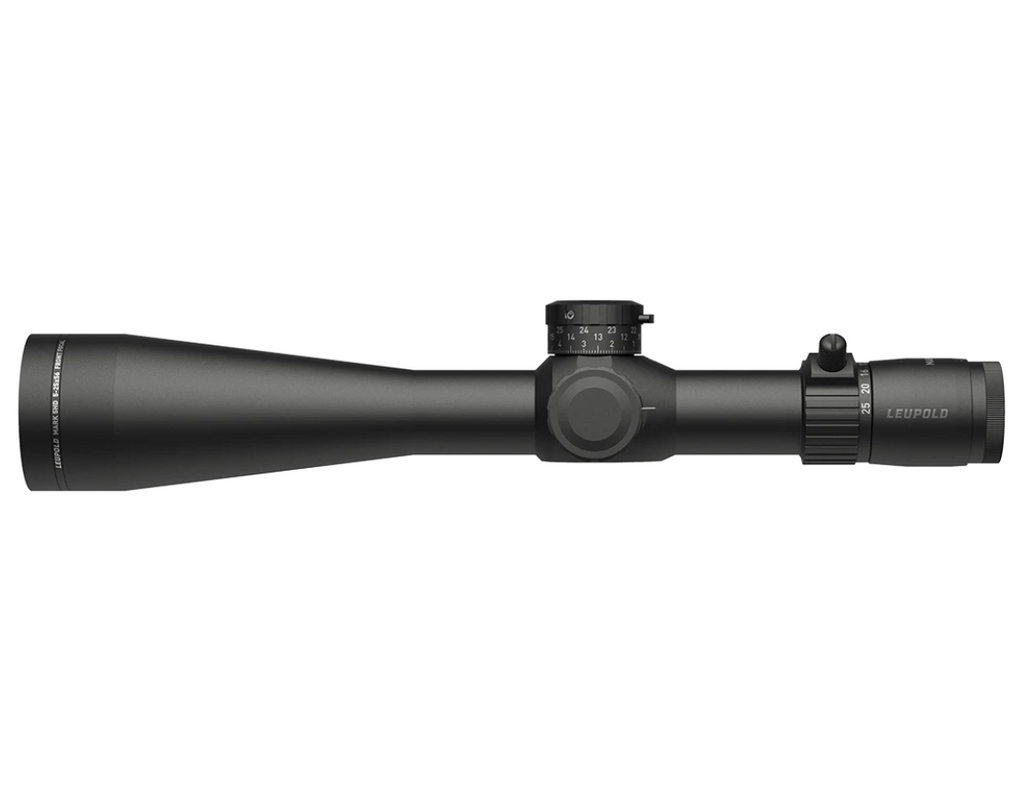
The Leupold Mark 5HD 5-25x56 is a high-end rifle scope designed for long-range shooting. It offers a wide magnification range of 5x to 25x, allowing shooters to engage targets at various distances with precision.
One of the standout features of the Mark 5HD is its turret adjustments. The turrets are highly tactile and provide crisp and precise adjustments for windage and elevation. They are also equipped with a zero stop feature, which allows shooters to quickly return to their zero settings without the need for counting clicks or relying on external tools. Additionally, the Mark 5HD has a built-in rangefinder that is paired with the optic, making long-range shooting even more efficient and accurate with MOA marks for quick holdover and wind holdoff.
Leupold is a renowned optics manufacturer known for its commitment to quality and performance. The Mark 5HD is no exception, featuring top-of-the-line glass and coatings that deliver exceptional image clarity and brightness. The scope also boasts excellent light transmission, ensuring clear visibility even in low-light conditions.
Overall, the Leupold Mark 5HD 5-25x56 is a premium rifle scope that offers the precision and reliability needed for long-range shooting. With its versatile magnification range and precise turret adjustments, this scope is a favorite among precision shooters and long-range hunters.
3. Nightforce ATACR 7-35x56 F1
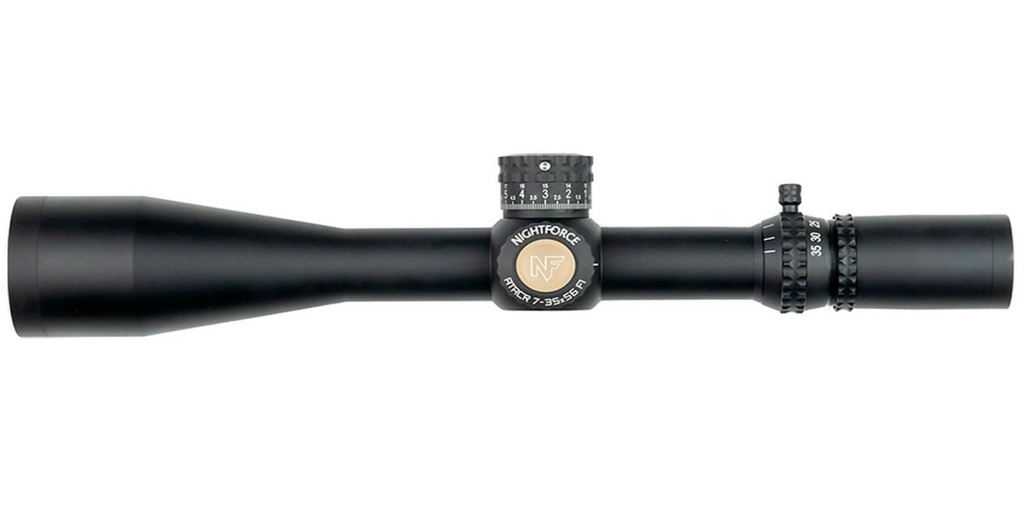
The Nightforce ATACR 7-35x56 F1 is a top-tier rifle scope designed for extreme long-range shooting. With a magnification range of 7x to 35x, this scope offers unparalleled zoom capabilities, allowing shooters to engage targets at incredibly long distances.
One of the standout features of the ATACR is its elevation adjustment. The scope is equipped with precise and repeatable turret adjustments for elevation, allowing shooters to make accurate bullet drop compensations at different distances. The turret controls are highly tactile and easy to use, ensuring quick and precise adjustments on the fly.
Nightforce is a renowned optics manufacturer known for its commitment to quality and precision. The ATACR is a testament to their expertise, featuring top-of-the-line glass and coatings that deliver exceptional image clarity and brightness. The scope also boasts a highly versatile reticle, allowing shooters to make precise holds and ranging calculations at various magnifications.
Overall, the Nightforce ATACR 7-35x56 F1 is a high-performance rifle scope that excels in extreme long-range shooting. With its high magnification capabilities, precise elevation adjustment, and versatile reticle, this scope is a favorite among competitive long-range shooters and precision hunters.
4. Schmidt & Bender PMII 5-25x56

The Schmidt & Bender PMII 5-25x56 is a top-tier rifle scope designed for precision shooters. With a magnification range of 5x to 25x, this scope offers excellent zoom capabilities for long-range shooting.
One of the standout features of the PMII is its windage turret. The turret controls are precise and allow shooters to make accurate windage adjustments on the fly. The scope also features a highly durable construction, making it resistant to shocks, water, and fog, ensuring reliable performance in any weather conditions.
Schmidt & Bender is a renowned German optics manufacturer known for its commitment to precision and durability. The PMII is a prime example of their expertise, featuring top-of-the-line glass and coatings that deliver exceptional image clarity and brightness. The scope also boasts a robust construction, ensuring long-lasting performance even in the harshest of environments.
Overall, the Schmidt & Bender PMII 5-25x56 is a high-performance rifle scope that is favored by precision shooters for its reliability and precision. With its versatile magnification range, precise windage adjustments, and durable construction, this scope is a top choice for long-range shooting.
5. Bushnell Elite Tactical XRS II
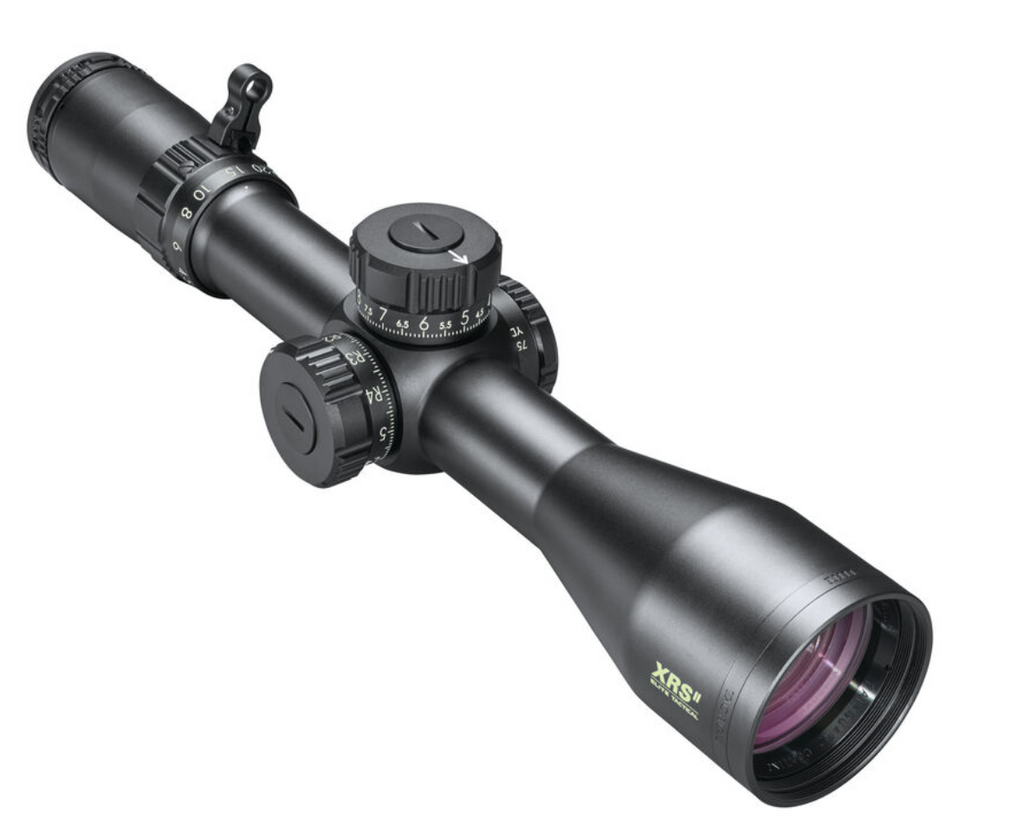
The Bushnell Elite Tactical XRS II is a versatile rifle scope that offers excellent performance for long-range shooting. With a magnification range of 4.5x to 30x, this scope provides shooters with the flexibility to engage targets at various distances.
One of the standout features of the XRS II is its reticle references. The scope is equipped with a reticle that features precise holdover and windage references, allowing shooters to make accurate holds and ranging calculations at different distances. The reticle is also illuminated, providing enhanced visibility in low-light conditions.
Bushnell is a well-known optics manufacturer known for its commitment to quality and performance. The XRS II is a testament to their expertise, featuring top-of-the-line glass and coatings that deliver exceptional image clarity and brightness. The scope also boasts a durable construction, ensuring reliable performance in the field.
Overall, the Bushnell Elite Tactical XRS II is a great option for hunters and precision shooters looking for a versatile rifle scope. With its wide magnification range, precise reticle references, and durable construction, this scope is a reliable choice for long-range shooting.
6. Zeiss Conquest V6 5-30x50
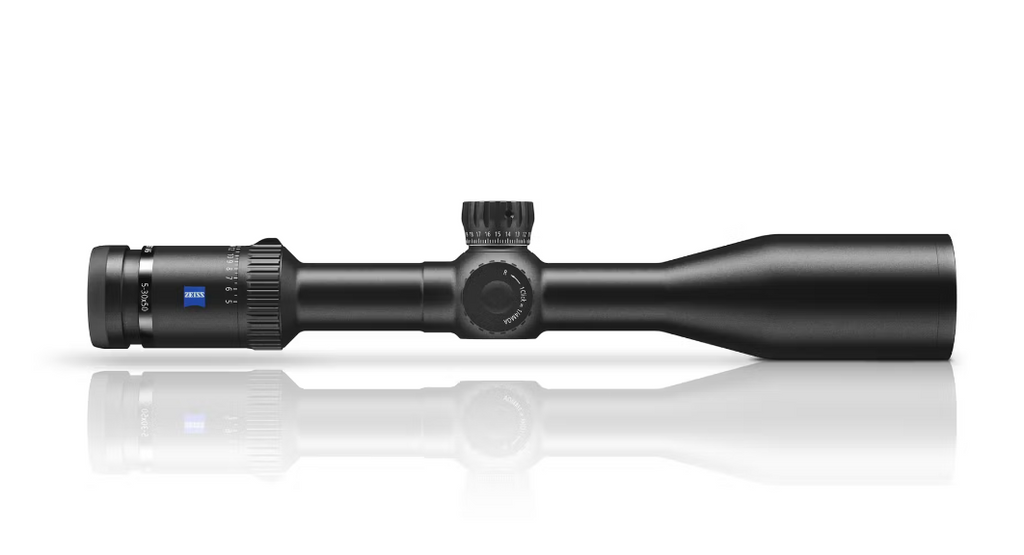
The Zeiss Conquest V6 5-30x50 is a high-quality rifle scope that offers exceptional optical performance for long-range shooting. With a magnification range of 5x to 30x, this scope provides shooters with the flexibility to engage targets at various distances.
One of the standout features of the Conquest V6 is its exceptional optical performance. The scope features top-of-the-line glass and coatings, delivering exceptional image clarity, brightness, and color fidelity. The scope also boasts a wide field of view, allowing shooters to easily track moving targets.
Zeiss is a renowned optics manufacturer known for its commitment to quality and precision (hence the reason our shooting glasses and tactical sunglasses utilize Zeiss lenses). The Conquest V6 is a prime example of their expertise, offering a versatile rifle scope that is well-suited for a wide range of shooting applications. The scope also features a parallax focus, allowing shooters to achieve optimal focus and eliminate parallax at different distances. However, one potential con of this scope is its fixed parallax focus at 100 yards, which may result in slightly fuzzy images for targets at varying distances. With a weight of 32.8 ounces and a 34mm tube, this scope is also on the heavier side compared to others on this list. Additionally, the Zeiss Conquest V6 comes with a lifetime transferable warranty, ensuring that your investment is protected for years to come.
Overall, the Zeiss Conquest V6 5-30x50 is a high-performance rifle scope that excels in long-range shooting. With its exceptional optical performance, wide magnification range, and parallax focus, this scope is a top choice for precision shooters and hunters alike.
Key Features to Look for in a Long-Range Rifle Scope
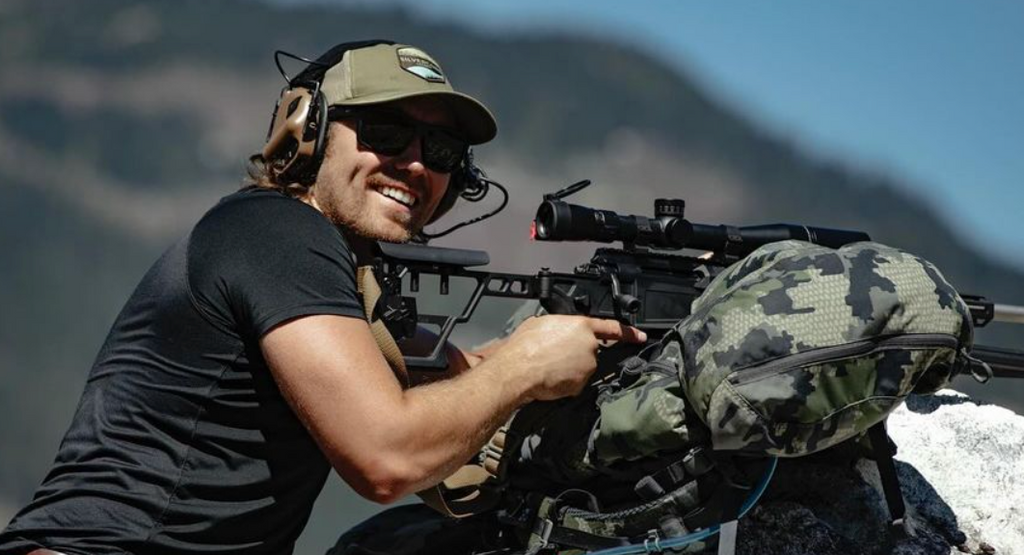
When choosing a long-range rifle scope, there are several key features to consider. These features can greatly impact your shooting experience and performance. Here are some important features to look for in a long-range rifle scope:
Considering these key features will help you choose a long-range rifle scope that best suits your shooting needs and preferences.
Magnification Range and Objective Lens Diameter
The magnification range and objective lens diameter are two important factors to consider when choosing a long-range rifle scope. These features determine the scope's zoom capabilities and light gathering abilities, respectively.
The magnification range refers to the range of zoom available on the scope. A wider magnification range allows for greater flexibility in engaging targets at different distances. For long-range shooting, a scope with a higher magnification range, such as 5x to 25x, provides the flexibility to engage targets at various distances.
The objective lens diameter determines the amount of light that enters the scope. A larger objective lens diameter allows for better light transmission, resulting in brighter and clearer images, especially in low-light conditions. However, it's important to note that a larger objective lens may also increase the size and weight of the scope.
Considering the magnification range and objective lens diameter will help you choose a long-range rifle scope that suits your shooting needs, offers versatility, and provides optimal image clarity and brightness.
First vs. Second Focal Plane Reticles
When choosing a long-range rifle scope, one key decision to make is whether to opt for a first focal plane (FFP) or second focal plane (SFP) reticle. Each type of reticle has its own advantages and considerations.
In an FFP scope, the reticle size changes with magnification. This means that the holdover points and ranging references on the reticle remain accurate at any magnification. This makes FFP scopes ideal for precision shooting, as the reticle can be used for holdovers and ranging calculations at any magnification. However, the reticle may appear small at lower magnifications, potentially making it difficult to see in low-light conditions.
In an SFP scope, the reticle remains the same size regardless of magnification. This means that the holdover points and ranging references on the reticle are accurate only at a specific magnification, usually the highest magnification. SFP scopes are typically preferred for hunting, as the reticle is easy to see and use at lower magnifications. However, holdover and ranging calculations may require adjustments based on the magnification, which can be done by using the dial on the scope.
Consider your shooting needs and preferences when choosing between an FFP and SFP reticle. If precision shooting and versatility are important, an FFP reticle may be the better choice. If ease of use and visibility are priorities, an SFP reticle may be more suitable.
Turret Adjustments and Tracking Accuracy
Turret adjustments play a crucial role in long-range shooting, as they allow shooters to make precise adjustments for windage and elevation. When choosing a long-range rifle scope, it's important to consider the quality and precision of the turret adjustments.
Look for turrets that provide precise and repeatable adjustments, ensuring that each click of the turret corresponds to a specific change in bullet trajectory. The turret controls should be easy to use and offer tactile feedback, allowing for quick and precise adjustments on the fly.
Tracking accuracy is another important consideration. A scope with good tracking accuracy will consistently return to zero after making adjustments. This ensures that the scope maintains its zero settings, allowing for consistent and reliable shooting performance.
When evaluating a scope's turret adjustments and tracking accuracy, it's helpful to read reviews and gather feedback from other shooters who have experience with the specific scope you're considering. This will help you assess the quality and performance of the turret adjustments and tracking accuracy.
Durability and Weather Resistance
Durability and weather resistance are crucial factors to consider when choosing a long-range rifle scope. A durable and weather-resistant scope is essential for reliable performance in various shooting conditions. Here are some key considerations for durability and weather resistance:
- Construction: Look for scopes with a robust construction, featuring high-quality materials that can withstand the rigors of shooting and handling. A rugged construction ensures that the scope remains functional and reliable even in demanding shooting scenarios.
- Weather Resistance: Consider scopes with weather-resistant features such as O-ring seals and nitrogen or argon purging. These features prevent moisture, dust, and debris from entering the scope, ensuring clear visibility and reliable performance in harsh weather conditions.
- Coatings: Opt for scopes with high-quality lens coatings, such as anti-reflective coatings and scratch-resistant coatings. These coatings enhance light transmission, reduce glare, and protect the lenses from scratches, ensuring optimal image clarity and brightness.
- Shock Resistance: Look for scopes with shock-resistant features that can withstand recoil and impact. These features ensure that the scope remains zeroed and functional even after heavy use and recoil.
Choosing a durable and weather-resistant scope will ensure that your long-range shooting experiences are consistent and reliable, regardless of the shooting conditions.
How to Mount and Zero Your Long-Range Rifle Scope
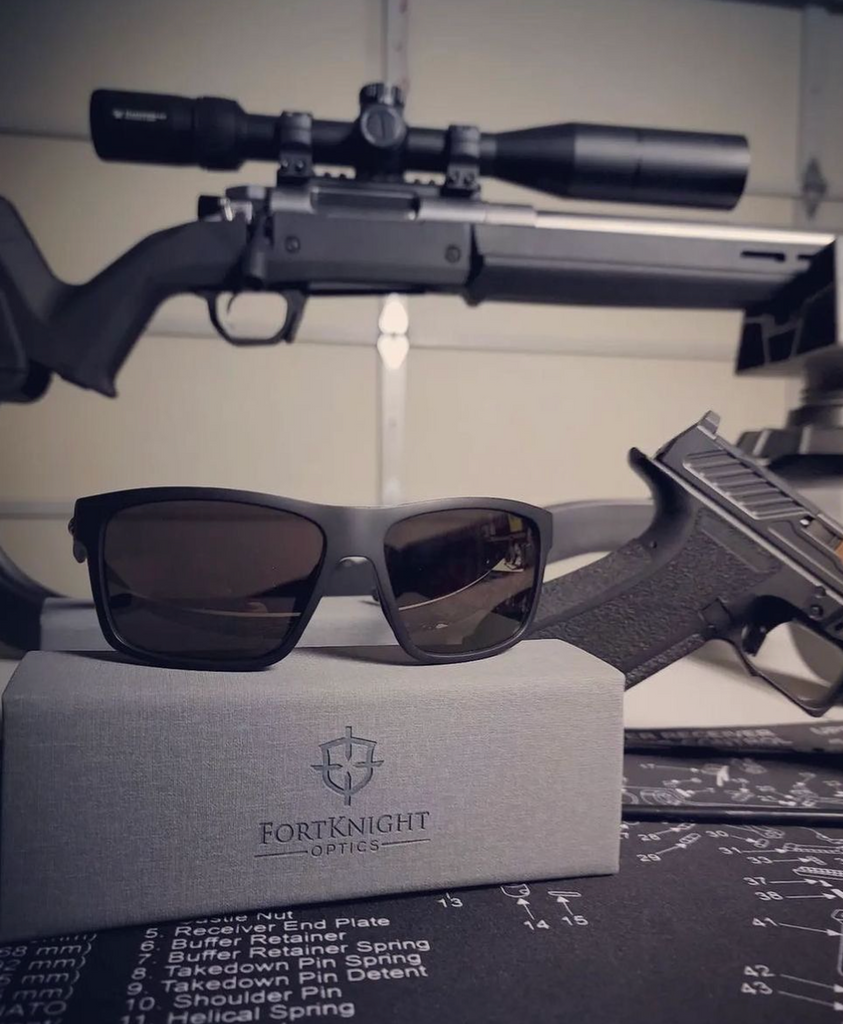
Mounting and zeroing your long-range rifle scope is crucial for accurate and consistent shooting. Properly mounting and zeroing your scope will ensure that the point of impact aligns with the point of aim, allowing for precise and reliable shot placement. Here are some key steps to follow when mounting and zeroing your long-range rifle scope:
- Mounting: Use high-quality scope rings or mounts to securely attach your scope to the rifle. Ensure that the scope is leveled and aligned with the bore of the rifle. Tighten the screws or bolts evenly to prevent any movement or shifting.
- Eye Relief: Adjust the position of the scope to achieve proper eye relief, which is the distance between your eye and the ocular lens of the scope. Achieving the correct eye relief will ensure a clear and comfortable field of view.
- Zeroing: Follow a systematic process to zero your scope, starting at a close distance and gradually moving to longer distances. Shoot a group of shots and make necessary adjustments to the windage and elevation turrets to align the point of impact with the point of aim. Continue this process until you achieve consistent and accurate shot placement.
- Zero Stop: If your scope has a zero stop feature, set it to prevent the turrets from moving beyond the zero settings. This allows for quick and easy return to zero settings.
By following these steps, you can properly mount and zero your long-range rifle scope, ensuring accurate and consistent shot placement in your shooting sessions.
Choosing the Right Mounts and Rings
Choosing the right mounts and rings is essential for securely and accurately mounting your long-range rifle scope. The quality and compatibility of the mounts and rings play a crucial role in the overall performance and reliability of the scope. Here are some key considerations when choosing mounts and rings for your rifle scope:
- Compatibility: Ensure that the mounts and rings are compatible with your rifle and scope. Consider factors such as the diameter of the scope tube and the type of mounting system on your rifle.
- Durability: Opt for high-quality mounts and rings that are built to withstand the recoil and impact generated by your specific firearm. Look for mounts and rings made from durable materials such as steel or aluminum.
- Precision: Choose mounts and rings that provide precise and repeatable alignment of the scope. This ensures that the scope remains securely mounted and maintains its zero settings.
- Installation: Consider the ease of installation and adjustment when choosing mounts and rings. Look for options that offer simple and reliable installation methods, allowing for quick and easy adjustment and removal if necessary.
By considering these factors, you can choose the right mounts and rings for your long-range rifle scope, ensuring secure and accurate mounting for optimal shooting performance.
Step-by-Step Guide to Zeroing Your Scope
Zeroing your scope is an essential step in ensuring accurate and consistent shot placement. It involves aligning the point of impact with the point of aim, allowing for precise and reliable shooting. Here is a step-by-step guide to zeroing your long-range rifle scope:
- Set up a target at a known distance. Start at a close range, such as 25 yards, to establish a preliminary zero.
- Take a series of shots at the target and observe the point of impact.
- Use the windage and elevation turrets on your scope to make adjustments based on the observed point of impact. Refer to the manufacturer's instructions for the specific adjustments needed.
- Shoot another group of shots and make further adjustments as necessary.
- Repeat this process at longer distances, gradually moving to the desired zero distance. Use a text table to keep track of the adjustments made at each distance.
Tips for Long-Range Shooting Success
Long-range shooting requires precision and accuracy. Here are some tips to improve your long-range shooting success:
- Practice regularly: Long-range shooting is a skill that requires practice. Spend time at the range, practicing different shooting positions and distances. This will help you become familiar with your rifle and scope, as well as improve your accuracy.
- Master windage and elevation adjustments: Understanding how wind and elevation affect bullet trajectory is crucial for long-range shooting. Learn how to make precise adjustments on your scope to compensate for windage and elevation changes.
- Use proper shooting techniques: Focus on maintaining a stable shooting position, controlling your breathing, and squeezing the trigger smoothly. These techniques will help improve your accuracy and consistency.
- Zero your scope: Zeroing your scope ensures that your point of aim and point of impact align at a specific distance. This is essential for accurate long-range shooting. Take the time to properly zero your scope before shooting at longer distances.
- Use a spotting scope: A spotting scope allows you to see your shots on target and make necessary adjustments. This is especially important for long-range shooting, as it can be difficult to see impacts at longer distances.
Remember, long-range shooting takes time and practice to master. Be patient, stay focused, and continue to refine your skills.
Understanding Windage and Elevation Adjustments
Windage and elevation adjustments are essential for accurate long-range shooting. Here's a closer look at what these terms mean and how they impact your shooting:
Windage: Windage refers to the horizontal adjustment on your scope. It allows you to compensate for wind drift, which can cause your bullet to veer off course. By making windage adjustments, you can correct for the wind's effect and ensure your bullet hits the target.
Elevation: Elevation refers to the vertical adjustment on your scope. It allows you to compensate for bullet drop over long distances. As the bullet travels farther, it will experience gravitational pull, causing it to drop. Making elevation adjustments ensures that your bullet's trajectory matches your point of aim.
Holdover: Holdover a technique used to compensate for bullet drop when you don't have time to make elevation adjustments. By aiming slightly above the target, you can account for bullet drop and still hit your mark.
Turret: Turrets are the knobs on your scope that allow you to make windage and elevation adjustments. They typically have distinct clicks to ensure precise adjustments. Understanding how to use your turrets effectively is crucial for accurate long-range shooting.
By mastering windage and elevation adjustments, you can improve your accuracy and hit targets at longer distances with confidence.
Frequently Asked Questions

How important is the objective lens size in a long-range scope?
The objective lens size in a long-range scope is important for several reasons. A larger objective lens allows more light to enter the scope, resulting in a brighter image. This is particularly beneficial in low-light conditions. Additionally, a larger objective lens can provide a wider field of view, allowing for better situational awareness. However, it's important to note that a larger objective lens can also increase the overall size and weight of the scope. It's important to find a balance between image quality, brightness, and the overall size and weight of the scope that suits your shooting needs.
First focal plane vs. second focal plane scopes: Which is better for long-range shooting?
The choice between a first focal plane (FFP) and a second focal plane (SFP) scope for long-range shooting depends on personal preference and shooting style. FFP scopes have a reticle that increases in size as magnification increases, allowing for precise holdovers and ranging at any magnification. This makes them ideal for precision shooting at variable distances. SFP scopes, on the other hand, have a reticle that remains the same size regardless of magnification. This can make them easier to use at lower magnifications and provide a clearer sight picture. Ultimately, it's best to try both types of scopes and decide which reticle type works best for your shooting needs and preferences.
How do I ensure my scope is properly mounted and aligned?
Properly mounting and aligning your scope is crucial for accurate shooting. Start by ensuring that your scope is securely mounted to your rifle using high-quality scope rings or mounts. Once mounted, align the reticle so that it is level with the rifle's bore. Use a plumb line or a scope leveling tool to achieve perfect alignment. Additionally, make sure to properly torque the scope rings or mounts to the manufacturer's specifications to ensure durability and prevent any movement or shifting during recoil. Finally, take the time to zero the scope by adjusting the windage and elevation turrets until your point of aim matches your point of impact at a specific distance. This will ensure that your scope is properly calibrated and ready for accurate shooting.
Can I use a long-range scope for hunting?
Yes, you can use a long-range scope for hunting. Many long-range scopes offer a wide magnification range and versatile reticles that can be used for both long-range shooting and hunting. These scopes provide the versatility and precision required for accurate shooting at various distances. However, it's important to consider your specific hunting needs and shooting conditions when choosing a scope. Factors such as the size of your intended game, shooting distances, and terrain should all be taken into account to ensure the best hunting scope for your needs.
What's the difference between MOA and MRAD adjustments?
MOA (Minute of Angle) and MRAD (Milliradian) are two different units of measurement used for turret adjustments in rifle scopes. MOA adjustments are based on a 1-inch movement at 100 yards, while MRAD adjustments are based on a 1-meter movement at 1000 meters. Both units of measurement are used to make precise adjustments to compensate for bullet drop and windage. The choice between MOA and MRAD adjustments depends on personal preference and familiarity. Some shooters prefer MOA for its simplicity and familiarity, while others prefer MRAD for its metric-based system and ease of use with a mil-dot reticle. Ultimately, both units of measurement can provide accurate adjustments for long-range shooting, so it's best to choose the one that you are most comfortable with.
How do atmospheric conditions affect long-range shooting?
Atmospheric conditions such as temperature, humidity, and air density can have a significant impact on long-range shooting. These conditions affect bullet flight by altering bullet velocity, wind drift, and bullet drop. Higher temperatures and humidity can cause bullets to have a higher muzzle velocity and experience less bullet drop. Conversely, lower temperatures and higher air density can result in lower muzzle velocity and increased bullet drop. Windage can also be affected by atmospheric conditions, with denser air causing more wind resistance and greater wind drift. It's important for long-range shooters to understand how these atmospheric conditions affect their bullets and make necessary adjustments for accurate shooting.
Don’t Get a Good Scope and Cheap Shooting Glasses
If you are looking at investing some money in a quality scope, why would you not invest in good shooting glasses? Whether you are looking at clear lenses for shooting in lowlight conditions or sunglasses to protect you from those UV rays, having a good pair of shooting glasses is a crucial part of your kit.
That being said, FortKnight Optics is home to plenty of great options for tactical eyewear to keep you safe on the range, such as the 308 glasses or even the 338. Check them out today!
Conclusion
In conclusion, selecting the right rifle scope is crucial for achieving precision in long-range shooting. Consider factors like magnification range, reticle type, turret adjustments, and durability. Proper mounting and zeroing are essential for optimal performance. Remember to practice windage and elevation adjustments for accuracy. Understanding your scope's features will enhance your shooting success. Explore the FAQs to address common queries and make an informed decision on the best rifle scope tailored to your shooting needs. Mastering these aspects will elevate your long-range shooting experience to new heights.
Be sure to follow FortKnight Optics on Instagram!






